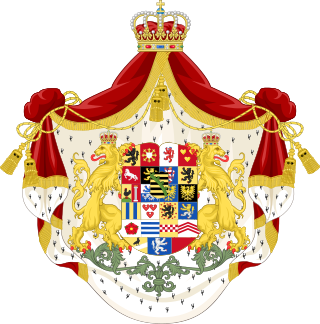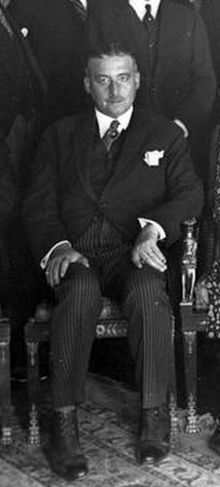
Leopold I was the first King of the Belgians, reigning from 21 July 1831 until his death in 1865.

Leopold III was King of the Belgians from 23 February 1934 until his abdication on 16 July 1951. At the outbreak of World War II, Leopold tried to maintain Belgian neutrality, but after the German invasion in May 1940, he surrendered his country, earning him much hostility, both at home and abroad.

Albert I was King of the Belgians from 23 December 1909 until his death in 1934.

Baudouin was King of the Belgians from 17 July 1951 until his death in 1993. He was the last Belgian king to be sovereign of the Congo, before it became independent in 1960 and became the Democratic Republic of the Congo.

Belgium is a constitutional, hereditary and popular monarchy. The monarch is titled King of the Belgians and serves as the country's head of state and commander-in-chief of the Belgian Armed Forces. There have been seven Belgian monarchs since independence in 1830.

Albert II is a member of the Belgian royal family who reigned as King of the Belgians from 9 August 1993 until his abdication on 21 July 2013.

Astrid of Sweden was a member of the Swedish House of Bernadotte and later became Queen of the Belgians as the first wife of King Leopold III. Following her marriage to Leopold in November 1926, she assumed the title of Duchess of Brabant. Astrid held the position of Queen of the Belgians from 23 February 1934 until her death in 1935. Known for her charitable efforts, she focused particularly on causes related to women and children.

Princess Lilian of Belgium, Princess of Réthy was the second wife of King Leopold III of Belgium. Born in the United Kingdom and raised in Belgium, she became a volunteer as a car driver that transported wounded Belgian and French to the hospital in Bruges during World War II. Lilian married King Leopold III in 1941 and became consort of the Belgian monarch. The couple had three children. She was also a stepmother to Leopold III's children from Queen Astrid and became the "first lady" of Belgium during the first nine years of her stepson King Baudouin's reign. Her charity work revolved around medicine and cardiology.

Prince Charles, Count of Flanders was a member of the Belgian royal family who served as regent of Belgium from 1944 until 1950, while a judicial commission investigated his elder brother, King Leopold III of Belgium, as to whether he betrayed the Allies of World War II by an allegedly premature surrender in 1940 and collaboration with the Nazis during the occupation of Belgium. Charles' regency ended when Leopold was allowed to return to Belgium. Shortly after returning and resuming his monarchical duties, Leopold abdicated in favour of his son, Baudouin.

The Order of Leopold is one of the three current Belgian national honorary orders of knighthood. It is the oldest and highest order of Belgium and is named in honour of its founder, King Leopold I. It consists of a military, a maritime and a civil division. The maritime division is only awarded to personnel of the merchant navy, and the military division to military personnel. The decoration was established on 11 July 1832 and is awarded by Royal decree.

Elisabeth of Bavaria was Queen of the Belgians from 23 December 1909 to 17 February 1934 as the wife of King Albert I, and a duchess in Bavaria by birth. She was the mother of King Leopold III of Belgium and of Queen Marie-José of Italy, and grandmother of kings Baudouin and Albert II of Belgium, and Grand Duchess Joséphine-Charlotte of Luxembourg.

The House of Saxe-Coburg and Gotha is a European royal house. It takes its name from its oldest domain, the Ernestine duchy of Saxe-Coburg and Gotha, and its members later sat on the thrones of Belgium, Bulgaria, Portugal, and the United Kingdom and its dominions.
Jacques-Théodule Cartier was a French jeweler and Cartier jewelry company executive.

Princess Marie-Esméralda of Belgium, Lady Moncada, is a member of the Belgian royal family. She is the half-aunt of King Philippe of Belgium and Henri, Grand Duke of Luxembourg. Princess Marie-Esméralda is a journalist, author, documentary-maker, environmental activist and a campaigner for the rights of women and indigenous people.

Jean-Sylvain Van de Weyer was a Belgian politician who served as the Belgian Minister at the Court of St. James's, effectively the ambassador to the United Kingdom, and briefly, as the prime minister of Belgium, all under King Leopold I.

The royal question was a major political crisis in Belgium that lasted from 1945 to 1951, coming to a head between March and August 1950. The question at stake surrounded whether King Leopold III could return to the country and resume his constitutional role amid allegations that his actions during World War II had been contrary to the provisions of the Belgian Constitution. It was eventually resolved by the abdication of Leopold in favour of his son King Baudouin in 1951.

Count Jacques Andres Coghen was the second Minister of Finance of the Kingdom of Belgium (1831-1832), and a direct ancestor of the current King, Philippe of Belgium.
Events in the year 1916 in Belgium.
The following lists events that happened during 1878 in the Kingdom of Belgium.
















